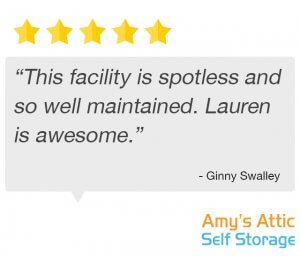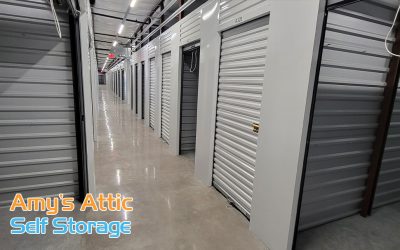Mini storage, also known as self-storage or storage units, refers to a type of service where individuals or businesses can rent a small storage space or locker to store their belongings, usually for a short period of time. Mini storage facilities typically offer a range of storage unit sizes, from small lockers to large rooms. Some storage facilities also offer climate-controlled units for sensitive items like artwork or electronics.
Mini storage units are often used to store items that people don’t have space for in their homes or businesses, such as seasonal decorations, sports equipment, or furniture. The units are also commonly used by Texas businesses to store excess inventory or archives. Renting a mini storage unit allows Texans to free up space in their homes or offices without having to get rid of their belongings, and provides a secure and accessible location for their items.
When did mini-storage become popular?
While storage has existed in different forms for centuries, modern mini storage gained momentum in the United States during the 1970s and 1980s. Several factors fueled this rise, including population growth (especially in Texas), rapid urbanization, and evolving lifestyles that led people to accumulate more possessions.
Between 1971 and 1989, Texas saw a population increase of nearly 46%:
| Year | Population |
|---|---|
| 1971 | 11,509,848 |
| 1973 | 12,019,543 |
| 1975 | 12,568,843 |
| 1977 | 13,193,050 |
| 1979 | 13,888,371 |
| 1981 | 14,746,318 |
| 1983 | 15,751,676 |
| 1985 | 16,272,734 |
| 1987 | 16,621,791 |
| 1989 | 16,806,735 |
The first modern self-storage facility was reportedly built in Odessa, Texas, during the mid-1960s. The concept quickly spread nationwide, and by the 1980s, thousands of mini storage facilities dotted the country.
Today, with more than 30 million people living in Texas, mini storage remains a go-to solution for extra space. Modern facilities now feature 24-hour access, climate-controlled units, gated entry, and online rental systems – making it easier than ever to rent a 10 x 10 storage unit near you.
What is the difference between “mini storage” and “self-storage?”
The terms “mini storage” and “self-storage” are often used interchangeably to refer to the same thing — the rental of storage units for personal or commercial use. However, some people use the term “mini storage” to describe smaller units, while “self-storage” can refer to facilities that also include larger units and more variety.
In general, the main difference between mini storage and self-storage lies in the size range of units available.
Mini Storage Units
Mini storage typically refers to facilities that offer smaller-sized units, often ranging from 5 x 5 (25 square feet) up to 10 x 10 (100 square feet). A 10 x 10 storage unit in Texas is one of the most popular options because it provides enough room for the contents of a one-bedroom apartment — including small furniture, boxes, and appliances — without being too large or costly.
These mini storage units are ideal for individuals who need short-term or seasonal storage, such as:
- Holiday decorations or seasonal items
- Sports or camping gear
- College dorm furniture
- Small household furniture or boxes during a move
- Documents and personal keepsakes
For convenient mini storage options in your area, explore Amy’s Attic Self Storage locations in Belton, Temple, or Waco, Texas.
Self-Storage Units
Self-storage, on the other hand, typically refers to facilities that offer a wider variety of unit sizes, including larger spaces such as 10 x 20 feet (200 square feet) or 10 x 30 feet (300 square feet). These are often used by businesses, families, or individuals who need to store:
- Commercial inventory or equipment
- Construction tools and machinery
- Larger furniture or home staging materials
- Vehicles, motorcycles, or small boats
- Pianos and bulky household items
These larger self-storage units in Texas are especially popular among local businesses needing extra warehouse space without committing to long-term leases.
Understanding the Overlap
It’s important to note that the terms “mini storage” and “self-storage” aren’t always used consistently across Texas. Different facilities may use them interchangeably depending on their marketing or facility setup.
The key when choosing a storage facility isn’t the terminology — it’s making sure the space meets your needs for:
- Size (from compact 5 x 5 to spacious 10 x 30 units)
- Location (choose a facility close to your home or business)
- Security (look for gated access and 24-hour surveillance)
- Convenience (options like drive-up access or climate-controlled units)
🡒 Find your perfect fit today — browse available unit sizes and prices at Amy’s Attic Self Storage.
Who coined the term mini storage?
It’s not totally clear exactly who coined the specific term “mini storage,” as the concept of renting small storage units has been around for decades. Nevertheless, the term “self-storage” is commonly used as a synonym for mini-storage, and it is believed to have been coined by the founder of the first modern self-storage facility, Russ Williams.
According to self-storage industry lore, Williams built the first self-storage facility in Odessa, Texas in the mid-1960s after noticing that people needed more space to store their possessions. Mr. Williams originally called his facility “Bunker,” but later changed the name to “A-1 U-Store-It.”
While the specific origin of the term “mini storage” is unclear, it is likely that the term was popularized in the 1970s and 1980s as the industry grew and facilities began offering smaller units to meet the needs of customers who didn’t need a large amount of storage space.
About self-storage pioneer Russ Williams
Russ Williams is a pioneer of the modern self-storage industry, and he is best known as the founder of the first self-storage facility in the United States. Williams was born in 1926 in Odessa, Texas, and he worked as an engineer in the oil industry before becoming an entrepreneur / pioneer in the self-storage industry.
In the mid-1960s, Williams noticed that Texans needed more space to store their possessions. He came up with the idea of renting out small, garage-like units for people to store their belongings. He built the first modern self-storage facility in Odessa, Texas, and he called it “Bunker” because the units were built into the ground like bomb shelters.
Williams later changed the name of his facility to “A-1 U-Store-It,” and he expanded his business to include other locations in Texas and beyond. Mr. Williams is credited with creating the modern self-storage industry, which has grown into a multi-billion dollar industry with thousands of facilities and employees across the country. Russ Williams passed away in 2006, but his legacy lives on in the self-storage industry.
About Amy’s Attic Self Storage
Amy’s Attic Self Storage is a locally owned, award-winning storage company serving Central Texas. With facilities in Belton, Waco, Temple, and nearby cities, Amy’s Attic offers a variety of unit sizes—from compact 5 x 5 spaces to expansive 10 x 30 units.
Customers can choose from:
-
Climate-controlled storage units for temperature-sensitive items
-
Drive-up access for easy loading and unloading
-
RV, boat, and vehicle storage
-
Online payments and reservations for convenience
-
24-hour surveillance and gated entry for peace of mind
Amy’s Attic is proud to hold a 4.7+ Google review rating across all locations and was honored with the Belton Chamber 2022 Business of the Year Award.
Find your nearest location:







